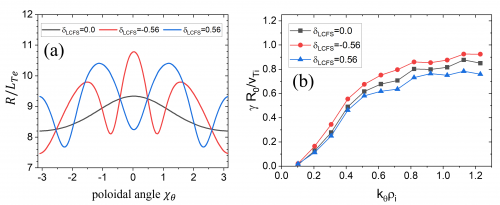Speaker
Description
One of the challenges in gyro-kinetic shaping study is the impact of reversed magnetic shear to the trapped electron mode (TEM) instability, which can only be handled by global gyro-kinetic simulations with kinetic electron response. The configuration with reversed magnetic shear is widely used in recent experiments since it provides the formation of internal transport barrier (ITB) structures and enhanced confinement in many devices [1]. However, the relation between plasma shaping effect and drift-wave instabilities in reversed magnetic shear plasmas has not been well understood. In this work, we extend the linear, δf version of global gyrokinetic code GKNET with kinetic electrons to the cylindrical coordinates (R,φ,Z), in which the effects from multi flux-surfaces are included, to study the shaping effect on linear drift-wave instabilities with reversed magnetic shear. The numerical equilibrium obtained from a fixed-boundary MHD equilibrium code TASK/EQ is utilized [2], and connect with GKNET code through the interface code IGS [3].
Detailed cross-verifications for hybrid-electron code and full-kinetic code are performed using Cyclone-based circular equilibria, in which all electrons are treated kinetically in the full-kinetic case and only trapped electrons are treated as kinetic in the hybrid case. The full-kinetic electron case shows a destabilizing effect from non-adiabatic passing electrons, resulting in larger linear growth rate in Ion Temperature Gradient (ITG) mode and Trapped Electron Mode (TEM) instabilities compared to the hybrid one. This result is also agreed with recent ORB5 full-kinetic electron calculations [4].
Based on equilibria with reversed magnetic shear, the influence of magnetic shaping on linear TEM instability is studied using the GKNET full-kinetic version. Due to the variations of shaping profiles and Shafranov shift under reversed magnetic shear, local temperature/density gradient and magnetic shear show different variations along the straight-field-line poloidal angle χ_θ in outboard mid-plane. Since linear TEMs mainly “feels” an averaged gradient near χ_θ~0 in the low field side, corresponding variations are responsible for the shaping effects on linear TEMs. In details, elongation is found to stabilize linear TEMs due to reduction of effective temperature and density gradient around χ_θ~0. As for triangularity, χ_θ distributions of gradients and shear show different tendency with triangularity. Figure (a) indicates that the negative triangularity case gives much larger local electron temperature gradient around χ_θ~0 than zero and positive triangularity cases. On the other hand, magnetic shears near the peak gradient location are nearly zero for all cases with different triangularity. As a result, the negative triangularity shows destabilizing effect to linear TEMs seen in figure (b) which is different to the findings in normal shear (monotonic safety factor profile) case previously [5].

[1] Ida K and Fujita T Plasma Physics and Controlled Fusion 2018 60 033001
[2] Fukuyama A, et al. APS Conf. 2002:QP1.042.
[3] Nakata M, et al. Plasma and Fusion Research 2014 9 1403029-1403029
[4] Dominski J, et al. Physics of Plasmas 2017 24 022308
[5] Camenen Y, et al. Nuclear fusion 2007 47 510
| Speaker's Affiliation | Rokkasho Fusion Institute, National Institutes for Quantum Science and Technology |
|---|---|
| Member State or IGO | Japan |
